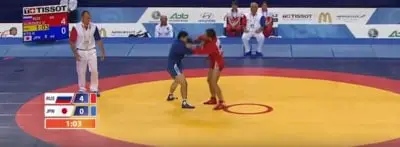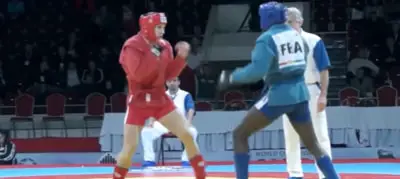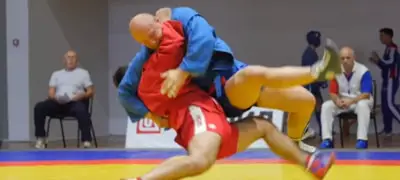
Sambo is mostly a grappling combat sport inspired by judo. There are plenty of sambists on the highest levels of today’s MMA. But why is that? How sambo practitioners are able to dominate using their sambo skills when fighting in the cage?
Why is Sambo so Effective in MMA and for Self-defense? Sambo fighters learn judo throws as well as Greco-roman and freestyle wrestling takedowns. They also spend a lot of time grappling and attacking for submissions on the ground (armbars, leg locks, kimuras, etc). So sambo incorporates almost all aspects of grappling.
On the feet combat sambo fighters are allowed to throw almost every strike possible (punches and kicks, elbows and knees and even headbutts). On the ground, they can also throw all those strikes as long as they don’t strike a grounded opponent while standing.
With that variety of techniques both on the ground and on the feet, sambo can claim to be the closest combat sport to a real fight. Even closer than MMA in some cases (we’ll discuss that later). That’s why is so effective in MMA and in fighting in general.
In the rest of the article I’m going to talk about in detail the techniques in sambo that can be applied in MMA, the two different types of sambo and which one is better for MMA and about the effectiveness of sambo in a self-defense (street fight) scenario.
Combat and Sport Sambo
Those are the two types of sambo. Sport sambo is the one that is similar to judo, but with leglocks allowed (and chokes forbidden). Sports sambo has also less grip restriction than judo.
The other type of sambo is combat sambo. This is the one where striking is allowed and it’s almost the same as MMA. There are minor rule differences (like the one that you can’t strike grounded opponent while you are on your feet). Unlike in MMA, in combat sambo there’s no cage. Competitors fight on a wrestling mat.
They also wear kimono-like jackets while MMA fighters fight shirtless. Combat sambo matches are only 5 minutes long (MMA matches are 15 or 25 minutes). And in combat samba, you can finish the fight not only by submission and by KO/TKO but also by scoring two knockdowns, by having a 12-point lead at any point of the fight (every throw, knockdown, and submission attempt give you a different amount of points) or by performing a perfect throw – throwing your opponent on his back hard while you remain standing.
Effectiveness of Sambo in MMA
Although there is striking in combat sambo, in case you don’t score a knockdown it’s not scored at all. That’s why sambo is more of a grappling martial art.
Sambo fighters focus on throwing their opponent to score points and keeping him on the ground to win on points or attack for submission. In MMA they most of them use the same strategy (the best example for that is Khabib Nurmagomedov).
In MMA throws and takedowns don’t give you that many points like in sambo but they bring the fight to the ground where sambo fighters can use ground and pound and control the opponent to prevent him from standing or attacking for submissions/reversals.
Sambo fighters have probably the most ferocious ground and pound we ever saw in MMA.
However, there are different types of sambo fighters. Some of them are really good at takedowns and throws. Others of controlling the opponent on the ground or attacking for submissions. But there are tons of pretty good kickboxers in sambo who finish the fights on the feet.
Another reason why sambo fighters are so good at grappling/wrestling and know so many techniques is that in Russia and some Eastern Europe countries Sambo fighters also are often training with Greco-roman and freestyle wrestlers as well as judokas. And sometimes compete in some of those sports where there are not sambo competitions.
Nowadays sambo fighters who want to compete in MMA also work on their BJJ and sometimes even Sanda to become more well-rounded. Sanda is a Chinese military martial art, similar to Sambo but more striking based.
That’s why if you look at the best fighters with a sambo background in MMA today (Khabi, Islam Makhachev) you’ll notice that they can not only grapple but also strike pretty well.
Drawbacks of Sambo in MMA
Combat sambo is the closest sport to MMA but they are not the same sport. Some differences in the rules make it hard for fighters to transition and they need to make some adjustments in order to be successful in the cage:
1. There’s no cage in combat sambo. That’s a huge difference especially if you are a grappler who likes to pressure his opponents. Cage wrestling (pressing your opponent against the cage and taking him down from there) is one of the biggest trends in MMA right now and if you are a sambo fighter you’ll lack some experience in that aspect of the game.
The good news is that this is a skill that sambo fighters and wrestlers learn pretty quickly. Examples for that are the best cage wrestlers in MMA right now – Khabib, Kamaru Usman, Colby Covington.
2. No jacket or shoes in MMA. The absence of shoes in maybe isn’t that big of a deal but the jacket is. Most of the throws in Sambo require a collar, lapel, sleeve grips or grips on the back of the jacket. Sambo fighters need to make some adjustments in their throws to make it effective without a jacket. The same adjustments judokas do when they transition to wrestling or grappling.
3. MMA matches are much longer. The 5-minute sambo matches are very explosive but if you are in a 15-minute or 25-minute MMA fight you need to learn to conserver your energy and explode only when you know you can score a takedown or plan a clean strike. Otherwise, you’ll gas out pretty quickly.
4. BJJ – There is grappling in sambo but it’s nowhere near on the level of BJJ when it comes to submissions and defense. The BJJ closed guard isn’t used that much in sambo. That can be a problem when transitioning to MMA because everyone there knows how to use the closed guard to defend themselves on the ground, to attack for submissions (armbars, triangle chokes, Omo platas) or to use sweeps.
Sambo fighters should 100% work on their BJJ before transitioning.
Sambo for self-defense
Sambo can be super effective for self-defense. Here are the main reasons why:
1. Quick fight: The main idea of sambo is to finish the fight as quickly as possible which is super important in a “street fight” scenario.
That’s a big difference between sambo and MMA, where MMA is a long contest and fighters approach it more strategically. That’s why they often start the first round slow. They know they have plenty of time and they want to first feel their opponent before becoming more aggressive.
On the other hand, sambo fights are short and you need to be quick and explosive and that is much more important for self-defense.
2. Throws: Avoiding fighting on the ground is a good idea when it comes to street fights. You don’t know if you’ll get attacked by more people when trying to control someone on the ground.
The goal of sambo throws is to remain standing while throwing your opponent on the ground with significant force. That way you stop the attacker quickly without risking fighting him on the ground.
3. Jacket: Some people think that Gi training (in BJJ; judo; sambo) is unrealistic but the jacket and the pants actually simulate the normal clothing pretty well.
In samba, the jacket is not only utilized to throw but also to choke out your opponent. And that’s super important, for self-defense you absolutely need to know how to choke someone out by utilizing his shirt/jacket.
There’s a cool video by Keenan Cornelius where he and his friends test different clothes when rolling to see if Gi-BJJ principles can be applied for self-defense. They tested sweatshirts, jackets and even managed to perform chokes using the opponent’s T-shirts. That’s a strong argument for the effectiveness of Gi-BJJ in a streetfight.



